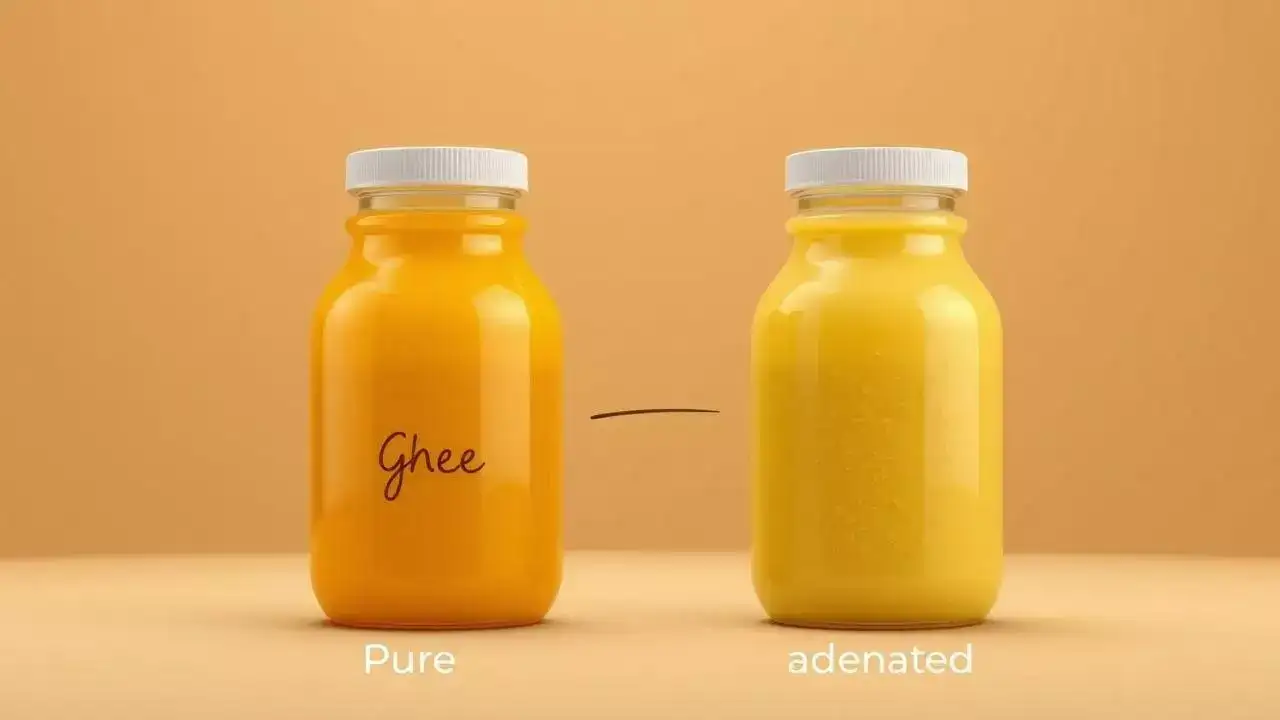How To Spot Adulterated Ghee & Avoid Falling For Fake Or Low-quality Brands
Ghee has long been a treasured part of traditional Indian and British-Asian kitchens, known for its rich aroma, nutty flavour, and numerous health benefits. However, as demand for pure ghee has risen, so too has the number of adulterated varieties on the market. Many manufacturers mix ghee with cheap oils, vanaspati, or synthetic substances to cut costs, compromising both its quality and nutritional value. Consuming adulterated ghee regularly can affect digestion, immunity, and overall wellbeing. Learning how to identify genuine ghee is essential to protect your health and ensure you’re getting the purity you pay for.


Image Courtesy: Meta AI

Understanding What Makes Ghee Pure
Pure ghee, also known as clarified butter, is made by gently simmering butter until the water evaporates and milk solids separate. What remains is golden, aromatic fat rich in healthy fatty acids and antioxidants. Authentic ghee is free from artificial colouring, preservatives, or vegetable oils. It solidifies at room temperature in cooler climates and has a grainy texture. Adulterated ghee, on the other hand, often contains cheaper fats such as palm oil or vanaspati that change its consistency, colour, and flavour. Recognising these differences can help you quickly identify purity.
Check the Colour and Texture
The appearance of ghee can reveal much about its quality. Pure ghee usually has a rich golden-yellow colour and a slightly granular texture when set. If the ghee looks too white, overly smooth, or has an artificial yellow tint, it may be adulterated. Synthetic dyes or palm oil are often used to mimic the golden hue of natural ghee. When you heat pure ghee, it should melt evenly and release a pleasant, nutty aroma, whereas adulterated ghee may have a greasy consistency and lack the distinctive smell.Smell and Taste Test
One of the easiest ways to spot adulterated ghee is through your senses. Pure ghee has a characteristic rich aroma that is both earthy and buttery. When you taste it, it should leave a smooth, pleasant aftertaste without any greasiness. Adulterated ghee, however, often smells rancid, waxy, or synthetic due to added oils and chemicals. It may also leave an oily film in the mouth or feel heavy after consumption. Trust your instincts—if the ghee smells off or tastes artificial, it’s best to avoid it.The Palm Oil Test
Palm oil is one of the most common adulterants in commercial ghee because it’s inexpensive and similar in appearance when solidified. To detect it, you can perform a simple at-home test. Take a small spoonful of ghee and place it in a transparent glass container. Keep it in the refrigerator for about 30 minutes. Pure ghee solidifies uniformly, maintaining a consistent texture. If you notice uneven layers, white patches, or separate oily regions, it’s a sign that other fats like palm oil or vanaspati have been mixed in.The Sugar Test for Detergent Adulteration
In some low-quality products, manufacturers use detergents or other emulsifiers to enhance texture and increase yield. To check for this, add a teaspoon of ghee to a glass of warm water and mix in a pinch of sugar. After a few minutes, if you observe foam formation on the surface, it indicates detergent contamination. Pure ghee will not create any froth, as it is entirely free from emulsifying agents.You may also like
- Delhi CM Rekha Gupta orders deployment of pollution-checking teams
- Telangana will never give another chance to Congress or Revanth Reddy: BRS' KTR
- Former Miss India and Bollywood actress shares emotional post after court hearing on soldier brother detained in UAE: 'You fought for us, bhai'
- "PM Modi will not make Nitish Kumar Chief Minister...": Kharge takes jibe at NDA
- Nitish Bharadwaj mourns the loss of his on-screen mother, Daya Dongre
The Iodine Test for Vegetable Oils
Vegetable oils such as soybean or sunflower oil are sometimes added to ghee to reduce production costs. You can detect their presence using the iodine test. Take a small quantity of melted ghee and add two to three drops of iodine solution (available at pharmacies). If the mixture turns blue or purple, it suggests the presence of starch or plant oils. Pure ghee will show no colour change in this test. Always exercise caution and perform the test in a well-ventilated area.Check Packaging and Labelling
When purchasing ghee, always examine the label carefully. Authentic ghee brands clearly list ingredients and display certification marks such as FSSAI, AGMARK, or ISO. Look for indications like “100% pure cow ghee” or “clarified butter” rather than vague terms like “premium blend.” Reputable brands also provide batch numbers, expiry dates, and contact information for consumer queries. Be wary of products sold at unusually low prices or in unsealed containers, as they are more likely to be adulterated.Storage Behaviour Test
Pure ghee has a long shelf life when stored in an airtight container at room temperature. Over time, it develops a rich, deepened aroma without turning rancid. Adulterated ghee, however, tends to spoil faster, develop unpleasant odours, or separate into layers. If your ghee turns watery or forms an oily surface quickly after opening, it’s likely impure. Always store ghee in a cool, dark place away from direct sunlight to maintain its freshness and prevent oxidation.Why Detecting Adulteration Matters
Consuming adulterated ghee can have serious health implications. Impure products may contain trans fats, synthetic additives, or harmful residues that increase the risk of heart disease, digestive problems, and inflammation. Ensuring the purity of ghee not only preserves its rich nutritional benefits—such as healthy fats, fat-soluble vitamins, and antioxidants—but also safeguards your family’s wellbeing. Choosing trusted brands and conducting simple home tests are easy yet effective ways to ensure that your ghee is genuine and wholesome.Image Courtesy: Meta AI









